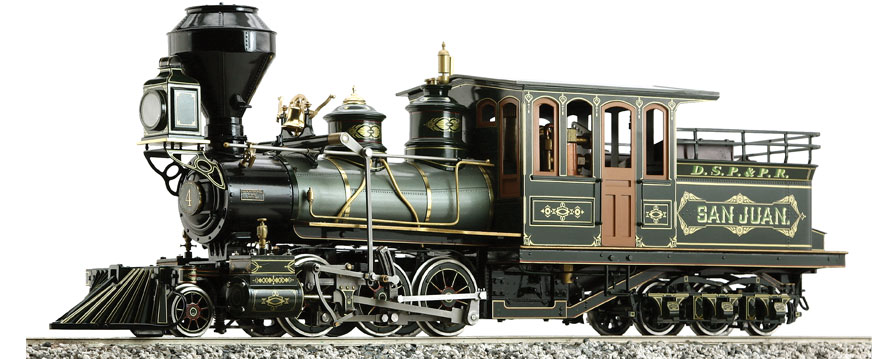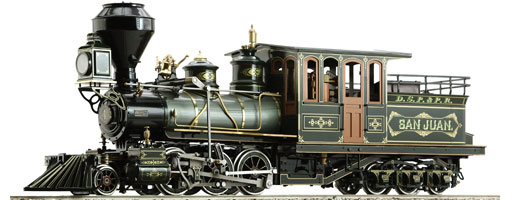| |

The name William Mason is synonymous with the 'Mason Bogie' - the most famous, yet least successful innovation of the Mason Works. Their artistry and architecture became the crowning achievement of the Mason Works and it is perhaps for that reason that these otherwise obscure but beautiful locomotives are remembered. The flexible Bogie Locomotive concept was not from William Mason, but came from the Scottish engineer, Robert Fairlie during the late 1860s. The Mason Bogie became the primary type of loco to be outshopped from the Mason works through the 1870s and early 1880s.
William Mason founded his locomotive works at Taunton, Massachusetts in 1852 after leaving a career in building textile machinery. Between 1853 and 1883 Mason built some of the most stunningly beautiful locomotives in the US, completing 700 by the year of his death. He was innovative, and rarely took accepted design philosophies at face value. Above all he believed his locomotives should be beautiful, and there is no doubt his were the most beautiful and refined machines of their time. His drive to remove undesirable clutter from the clean lines of a locomotive brought about many innovations in locomotive architecture. He was the first to use horizontal cylinders on the long framed locomotives such as the 4-4-0. To avoid the ungainly, asymmetric appearance of counterweighted wheels, he used the hollow cast iron spokes, and pouring lead into the voids to counterweight. Perhaps Mason's most famous contribution was the adoption of the Walschaerts valve gear, the first in the US, used on one of his Mason Bogies in 1874. With Mason's entry into locomotive design came some notable changes to the locomotive form and decoration, which became a virtual architectural standard in locomotive design by the 1870s. This was the period of Industrial artistry, where buildings as well as machinery were highly appointed and coordination of form, colour and decoration was paramount. During the 1800s America was in the grip of yet another Classical revival period, influencing architectural form, machinery and locomotive design. Classical form had a direct effect on the human psyche; the grand porticos and colonnades had long been associated with officialdom, power and stature, and with the growth of the railroads through the 1800s, these classical devices were again used to evoke feelings of power, stability and pride in the railroad.
Mason translated classical concepts into locomotive Architecture. The most notable element to come from the Mason works in the mid 1850s was the development of the 'ringed' or 'fluted' dome. This became one of the most recognized elements of US locomotive design, with almost all US builders adopting their own version by the 1870s. The fluted dome itself was essentially inspired by classical column elements, from the base and head of columns from the Doric order. Other architectural features also adorned US locomotives, including cabs with arched windows set to classical proportion and steam chests corniced in classical form.
The South Park Masons are probably the most well known of all Mason Bogie locomotives built. The line would own the 2nd largest fleet of Bogie locos at 23 built between 1878 and 1880. The largest fleet of Mason locomotives however was managed by the Boston Revere, Beach & Lynn RR in Massachusetts.
The Bogie Locomotive concept slowly faded after Mason's death in 1883. While the Mason Bogie is little more than a decorative footnote in the history of locomotive design, the concepts did not die with it. In the years that followed, the virtues that Mason considered mandatory in locomotive design resurfaced in the Meyer locomotive, Garratt locomotive, the articulated Mallet locomotives and today virtually every electric and diesel locomotive is a twin truck design carrying the entire weight of the locomotive and ensuring that all of its weight including fuel loads contributes to operational efficiency.
Upon the passing of William Mason in 1883, friend and locomotive authority, M.N. Forney, wrote: "He was a wonderfully ingenious man and combined with his ingenuity a high order of artistic sense, so that his work was always most exquisitely designed. It might be said of his locomotives that they are melodies cast and wrought in metal."
Specifications
Scale / Gauge
Construction
Mini. Radius
Length
Width
Height
1:20.3 / 45 mm
Brass & Stainless Steel
4 ft.
22.4 in. (569.4 mm)
4.7 in. (118.5 mm)
7.5 in (189.8 mm)
Features
0-24V DC motor
Sound ready
Models
AL88-751
Mason Bogie 2-6-6T DSP&P #4
'San Juan', Dark Green
Electric
AL88-752
Mason Bogie 2-6-6T DSP&P #6
'Tenmile', Chocolate Brown
Electric
|
|






